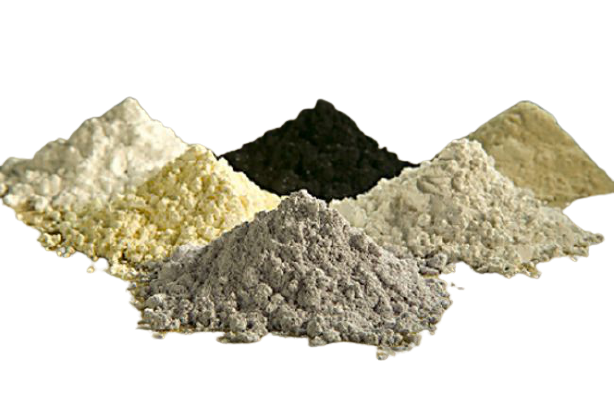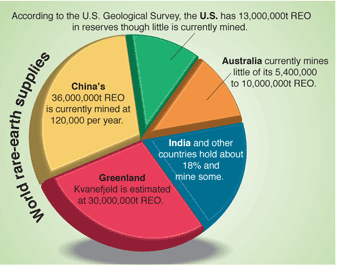
- Rare earth is used in the manufacturing of important parts in electronic devices.
- China has 36.7% of all the rare metal deposits followed by Brazil with 22%, Vietnam with 18%, and Russia with 10%.
- Till 2010 China had a virtual monopoly over the supply of rare metals with 90% of the market share.
- The US was also affected by the monopoly of China. During the recent trade war between the US and China, the latter tried to use its leverage to gain an advantage.
- India in this regard isn’t at an overwhelming disadvantage as it has around 5% of the world deposits.
- Despite its vast deposits, India managed to produce only 1% of the rare metals in the world in 2020.
- India must clear the monopoly of the public sector and make room for private players to invest and produce.
Electronic devices have become an indispensable part of daily life. From banking to socializing to shopping humans are dependent on electronic devices. The current situation of the pandemic has only increased the necessity of it. There is a critical aspect of the majority of electronic devices that many are unaware of, that is rare earth elements.
Rare earth is a group of elements that are not commonly found and difficult to extract. Rare earth is used in the manufacturing of important parts in electronic devices. A total of 17 metals are included in this category. Some of them are neodymium, lanthanum, europium, scandium, yttrium.
Among these neodymium is extensively used in the manufacturing of electric vehicles the combination of neodymium And lithium is critical in car batteries. Rare earth metals produce rare earth permanent magnets (REPM) is the most powerful permanent magnet used in electric car batteries which do not weaken easily with time. Europium is used in producing and developing the targeting system in the weapons. Rare metals are used in mobiles, hybrid vehicles, airplanes, radars, sonars, etc.
As the world is moving towards renewable energy The necessity and the usage of rare metals is projected to increase.
Rare earth can be found in many parts of the world. China has 36.7% of all the rare metal deposits followed by Brazil with 22%, Vietnam with 18%, and Russia with 10%. India stands fifth with 5% of all the deposits.
Rare earth is not only found in trace amounts in the course but the process of extraction is tedious and environmentally harmful. It also leaves behind a lot of radioactive waste, disposal of which has complications of its own.
China Seized the Opportunity
Till 2010 China had a virtual monopoly over the supply of rare metals with 90% of the market share. This might be due to the political structure which ignores the environmental impact. This might also be because China has vast areas of the inhabited desert for disposal and storage of radioactive waste. Using this as an opportunity many countries exported the mined ores to China and imported the processed metal for its usage. China recognizing the situation has leveraged it on the international stage.
In 2010, a Japanese commander seized a Chinese fishing boat and arrested its captain near the Japanese Senkaku Islands, over which China claims its rights. China retaliated by stopping all the exports of rare earth metals to Japan. This triggered the Japanese companies to Force the government to pursue peace settlements. China not only settled but with the condition of increasing manufacturing in its own country. Recognizing the gravity of the situation some Japanese companies invested around $2 billion in Australia for mining and processing of rare earth. Now one-third of the Japanese needs are procured from Australia.

The US was also affected by the monopoly of China. During the recent trade war between the US and China, the latter tried to use its leverage to gain an advantage. China’s President Xi Jinping visited the earth facility which was seen by many experts as a subtle message of its importance. The US depends heavily on China for their rare earth needs. Rare earth is quintessential in their pursuit of technological advancement. They are also used in defense equipment. For example, one USF 35 stealth aircraft contains around 427 kgs of rare earth metals and a Virginia nuclear submarine contains around 4.2 tonnes of rare earth metals.
Although China’s monopoly in rare earth reduced during the last decade, it still has around 60% control of the market. Sensing the growing demand it has also been aggressively securing mineral sand mining concession around the Indian Ocean region. Having a long-term strategic planning Deng Xiaoping had in 1992 said if the middle east has oil China has rare earth.
Rare Earth & India
India in this regard isn’t at an overwhelming disadvantage as it has around 5% of the world deposits. India has also created a public sector company exclusively for rare earth materials called Indian rare earth Ltd which has a monopoly to extract and monetize the rare earth deposits. The company extracted thorium from the Indian coastline sent and supplied it to the Department of atomic energy.
But a proactive role is needed as India imports most of its needs from China. In 2020 despite its vast deposits India managed to produce only 1% of the rare metals in the world. When the US mined 36,000 tonnes, comparatively India managed to produce only 3000 tonnes of Rare earth metals.

Recently there has been some progress as the government has expressed its interest in Parliament to start the deep-sea expedition in and around the Indian Ocean region which is rich in mineral sands. Recently Prime Minister in his address to CII asked them to join hands with the government to efficiently utilize the resources which many experts speculate may be an indication towards concentrating on rare earth.
India must clear the monopoly of the public sector and make room for private players to invest and produce. Due to its strategic significance and environmental implications, India might consider creating an autonomous regulator to oversee the production and trading of these metals.
Quad has a role
Quad alliance becomes interesting in this regard. As mentioned above, the Quad countries are affected by the monopoly of one country in rare earth metals. This might be a strategic partnership considering the vast resources of India with the technology of the US and Japan and the huge amount of inhabited land in Australia. India might also consider cooperating and researching with others for efficient production and utilization of rare earth.
Shreyas has an M.Sc. in Psychology and serves in NIMHANS. He writes regularly on politics, society, international affairs and technology. Views expressed are the author’s own and do not necessarily reflect the views of SamvadaWorld or its staff.
